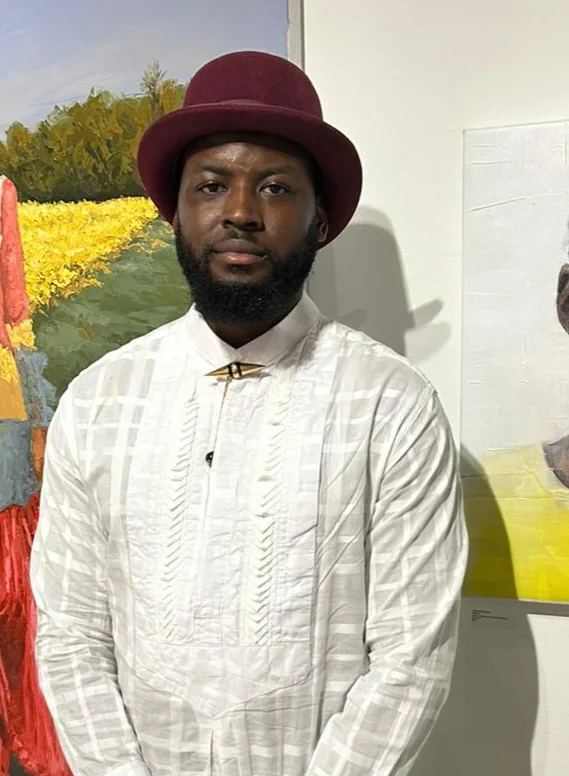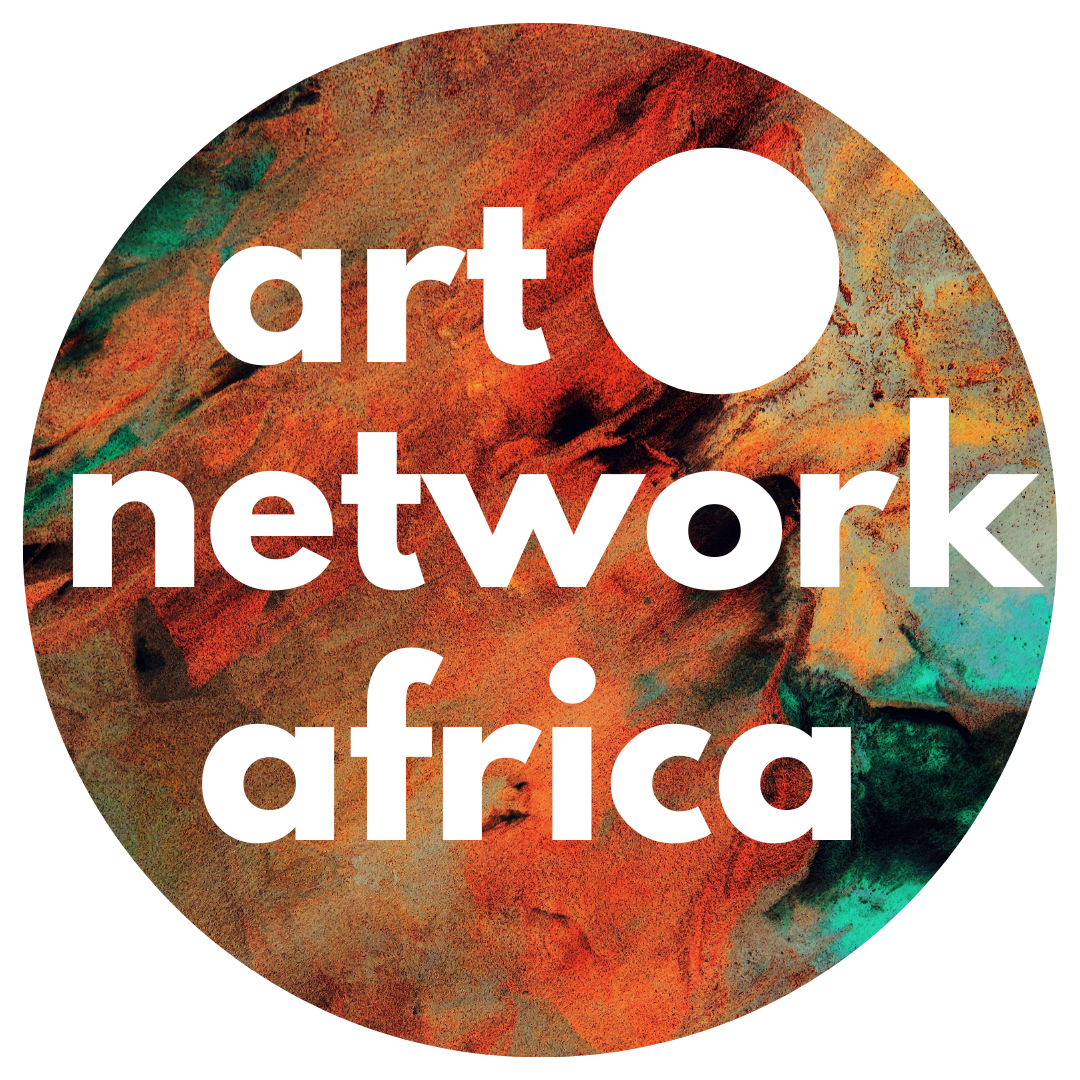Lagos-based artist Odeyemi Oluwaseun paints young adults and adolescents, capturing the triumphs and challenges encountered in the process of self-discovery. The artist’s second solo exhibition, “The Dualities of Existence,” at Mitochondria Gallery in Houston, Texas, presents his newest composition of work—an introspective outlook on the relative and absolute realities of life.
The figurative paintings composed by Odeyemi in this exhibition are filled with warm colors generated from layers of acrylic paint, charcoal, and conte crayons, which he meticulously implements to capture the essence of his subjects. This approach engulfs viewers in the scenes depicted. Odeyemi’s artistic vernacular shows its singularity in the way he composes the skin of his subjects; creating a maze of non-uniform monochromatic lines that generate random patterns unique to each subject in his work. This sight of contention in Odeyemi’s work serves as a symbol of individuality and togetherness.
Recently, we caught up with Odeyemi, who shared insights into his artistic practice, influences, and his desire to capture human emotions.
T.E: When did you first realize you wanted to be a visual artist? Can you share the journey that led you to this point?
O.O: I have been into art for as long as I can remember. I started making art in my childhood days, drawing comics, inscribing drawings on walls, and using clay soil to make colors. However, my artistic intuition developed further when I chose the kind of high school I attended. Fast forward to 2012, during my National Diploma program, that was when I noticed something special about my talent. I decided to pursue art as a career by enrolling in a bachelor’s degree program in art to learn and understand the historical aspects of art.
The academic training I underwent marked the beginning of my journey as an artist. I had the opportunity to meet different masters, mentors, and colleagues. Before, I was only creating art for passion, but later, I realized that art is both a passion and a business. It is something you can make a living from.
T.E: Have your personal experiences significantly impacted the themes or styles in your art?
O.O: Personally, art plays a significant role in my day-to-day life. As an artist, I use my work to discuss life experiences, relationships, and emotional dialogues. My subjects are mostly figurative, drawing inspiration from African scenes that resonate with the ideas I want to portray. My themes are centered around personal experiences. If you recall, in my first solo exhibition, RESILIENCE, I discussed challenges, courage, struggles, and survival faced during the transition from adolescence to adulthood. The Duality of Existence is another powerful theme that sheds light on how we need to look at life from both sides.
The non-continuous textural approach I employ, in an anisotropic arrangement and monochromatic color scheme with dramatic line work, speaks volumes in my artistic language. It represents the strength, struggle, survival, and courage of the black community.

Image courtesy of Mitochondria Gallery
T.E: Who would you say has had a significant impact on your work?
Sure, firstly, I appreciate everybody who contributed to my artistic development. Let me start with my contemporary colleagues with whom I share information and ideas. (Because information is the key to success.) My studio-mates, mentors, and other master’s in art have been instrumental in my learning, drawing resources to develop and re-establish academic ideas from a professional standpoint. I believe art has a way of helping us express ourselves through the experiences of others that we see or hear. Our journey is influenced by what we observe and hear. In essence, we live in a world where learning from others and building upon that knowledge is paramount. It always allows us to stay on track and pursue greater heights.
O.O: What was the initial idea that led to the creation of ‘The Duality of Existence’?
Thinking about how life evolves and changes in different directions, I reflect on my first solo show where I discussed the factors that guide our livelihood: Survival, struggle, strength, and courage to face all the fear and adversity in life. I couldn’t complete the message in that body of work, so I decided to continue it, looking at life from different perspectives. Duality sparked the idea that everything serves different purposes in life. The Duality of Existence allows us to see more in life as we live it—focus on the light in the darkness, joy in pain, and strength in weakness. Life’s totality is duality; not all bad is truly bad, and some good will come with pain. The opposing forces and phenomena reflect the very essence of human existence. It is through these contrasting experiences that we come to comprehend the depth and richness of life itself.

Image courtesy of Mitochondria Gallery
T.E: Who are the people you represent in this body of work, and why did you choose to capture them?
O.O: Mostly, my subjects are people I know. I choose pictures because I feel connected to them. I choose to capture them in my work because their presence or the story behind the image resonates with me. At times, I use source materials that are not mine; it doesn’t have to be mine. In such cases, I seek permission from the original source before incorporating it into my artwork. Ultimately, what interests me is not so much the exact origin of the reference material, but rather what it represents or symbolizes in the context of my artwork. I aim to capture the essence, emotions, or narrative of the subject, regardless of whether it is a personal photograph or another form of visual reference.
T.E: Can you discuss any challenges experienced while creating the pieces in this body of work?
O.O: Every new piece of art you work on has different challenges than the previous one. Let me start from the angle of adding new elements, scenes, environments, and settings to the whole body of work. My first solo project was all in flat white backgrounds with fewer details, but the duality of existence led me to bring in new compositional ideas, interior settings, more details, the use of colors, contrast, value, and texture.
During the process of creating my solo project, I had an accident that almost disrupted the exhibition plan. However, due to the understanding between the artist and the gallery, we agreed to put a stop until I fully recovered. So, after getting better, I returned to my easel to finish the project.

Image courtesy of Mitochondria Gallery
T.E: What advice can you give to other artists at the beginning stages of their careers?
O.O: My advice is brief. Firstly, there is no shortcut to success. Trust the process and be disciplined. Embrace humility and be content. Secondly, do what is necessary: study hard, read, learn, and be willing to unlearn. The sky will be your starting point.

Timi Etebu is a writer based in Houston, Texas. His interests are in amplifying the voices of artists from Africa and the African Diaspora.


